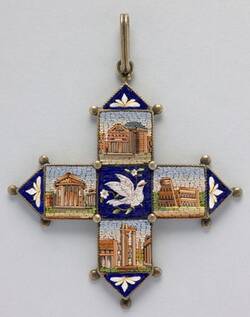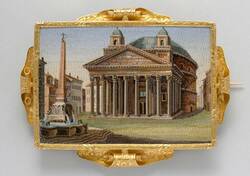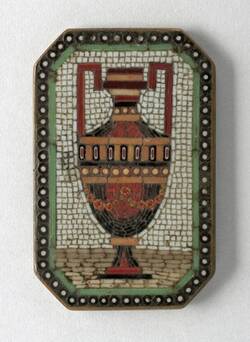Further Media
The term ‘micromosaic’, which aptly describes the pieces of jewellery exhibited here, was coined by the important English collector Sir Arthur Gilbert (1913-2001). In the course of his long life, he succeeded in building up by far the most important collection of such objects worldwide. Named after him and his wife Rosalind, it is now kept at the Victoria & Albert Museum in London. It offers numerous parallels to the motifs presented here.
The technique of micromosaic, in which tiny glass or enamel tiles are joined together, was already prized in Antiquity for its durability, which was much higher than for panel and wall painting. It is no coincidence that Rome became one of the most important production sites. Mosaics adorn the naves and apses of numerous medieval churches there. In the late sixteenth century, a workshop was set up in the Vatican to replace paintings in Saint Peter’s Basilica with micromosaics. From this tradition, a production specifically geared to tourism developed during the heyday of the Grand Tour. The period of the greatest international dissemination, which also includes the production of the pieces gathered here, are the late eighteenth and early nineteenth centuries. Due to the high demand, there were already more than twenty additional private workshops by 1810, most of them concentrated around the Piazza di Spagna.
Although the Vatican production is well documented, with some artists even clearly identifiable, authorship is rarely a decisive factor in the evaluation of micromosaics. Even dating can only be estimated in the vast majority of cases. It is the fineness of execution and the complexity of the motif that matter. It is hardly surprising that the most popular tourist destinations are also the most common motifs found in micromosaics. The two gold-framed brooches, for example, depict the great waterfall of Tivoli - a popular destination at least since Goethe’s famous trip to Italy - and the Pantheon, the most completely preserved ancient building in Rome. The cruciform pendant shows - in addition to the Pantheon - three other important ancient sites: the Temple of Hercules Victor, the Roman Forum and the Colosseum. The two objects with amphorae are jewellery plates for rings: direct comparative examples are preserved at the Victoria & Albert Museum.
Text: Alexander Röstel



